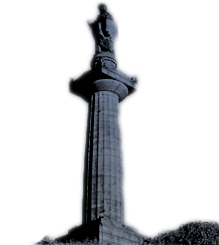A few small scraps have been gleaned about Casimir in the 1880s. A brief extract from The Building News and Engineering Journal vol 39 1881 records his election as borough surveyor and engineer for “the town” [Tynemouth?] at a salary of £300 per annum; he had formerly been an assistant in the surveyor’s office at North Shields. He seems to have become a member of the Association of Municipal and Sanitary Engineers and Surveyors by 1885/6 when he is found in a membership list.
The two most intriguing scraps are first, that Casimir, as Borough Engineer of Tynemouth, was responsible for designing Tynemouth Watch Club House, 1886-7, which is a Grade II listed building. The second titbit is that Casimir was a captain in the Tynemouth Artillery Volunteers, and there is probably a photograph of him in uniform extant.
Casimir may have left his job at Tynemouth in the late 1880s and gone abroad to work. The evidence for this is firstly the death of his wife Mary at Monte Video in 1889 at only 29 years of age. On at least three occasions (1894-1897) In Memoriam notices were placed in English newspapers to commemorate her death. Secondly there are two records of Casimir returning to this country from abroad in surviving Passenger Lists. In 1896 Casimir arrived on the Norman which had sailed from Natal, Brazil, calling at New York before arriving in England. In 1909 Casimir arrived from Monte Video on the Corinthic.
By 1911 Casimir was settled in London, boarding with the Skene family when the census was taken. He did not die until 1928, in Cricklewood, Middlesex and was buried in Kensal Green General Cemetery. He left £1,939 12s 11d.
Considering how unusual Gomoszynski is as a surname in Britain it is rather surprising that Joseph’s family do not occur more often in the records. It is likely that one reason they cannot be found is that their surname is being wrongly transcribed and indexed but nevertheless the gaps are very big. One of the biggest questions is where was Casimir for the first 35 years of his life? One can appreciate that he may not be with his mother or siblings if he is at boarding school but where did he go to study as a civil engineer? His later life from c1888 until his appearance in the 1911 census is equally a mystery. This is why the suggestion that he was working abroad is so attractive. The fates of Emily and Catherine are equally puzzling. Two stray appearances in the 1891 and 1911 censuses don’t help to fill many gaps, particularly as in both instances the sisters are described as visiting the respective census households. Where did they live between their mother’s death in 1877 and Emily’s in 1897? Did they live together? Did Catherine normally live with Casimir after he returned to England but was away visiting on Census night 1911? The questions go on – maybe some readers can help elucidate some of the dark corners.
SOURCES from the Internet
1841 Census for Headingley, Leeds
1861 census for St Marylebone
1871 census for Llandrillo
1881 census for Morpeth
1891 census for Elswick, Newcastle upon Tyne
1911 census for E Dulwich
1911 census for Paddington
Civil Registrations of England, Births, Marriages, Deaths – Indexes
Greenock Advertiser 31 December 1839, 28 October 1845, 17 July 1846 – BMD abstracts.
Hutcheson’s Greenock Register, Directory, and General Advertiser for 1845-46. Greenock, 1845.
National Probate Calendar at Ancestry.com
Passenger Lists at Ancestry.com
Proceedings of the Association of Municipal and Sanitary Engineers and Surveyors. Volume XII. – 1885-86.
The Bradford Observer January 20, 1842, January 27, 1842
The Building News and Engineering Journal vol 39 1881
The Gentleman’s magazine, Volume 173, 1843
The Liverpool Mercury, December 3, 1841
The Standard June 21, 1894, June 20, 1896, June 21, 1897
The Times, Tuesday, Mar 27, 1928
Tynemouth in old picture postcards, by Eric Hollerton
Wikipedia









